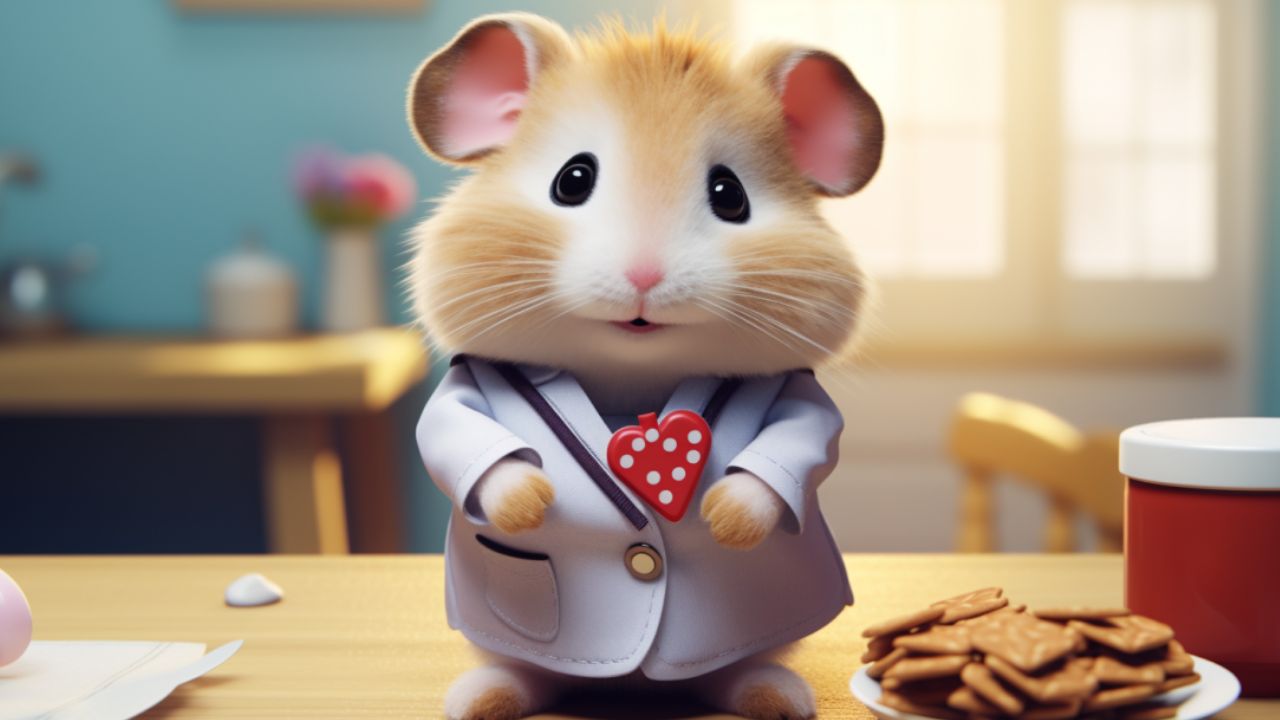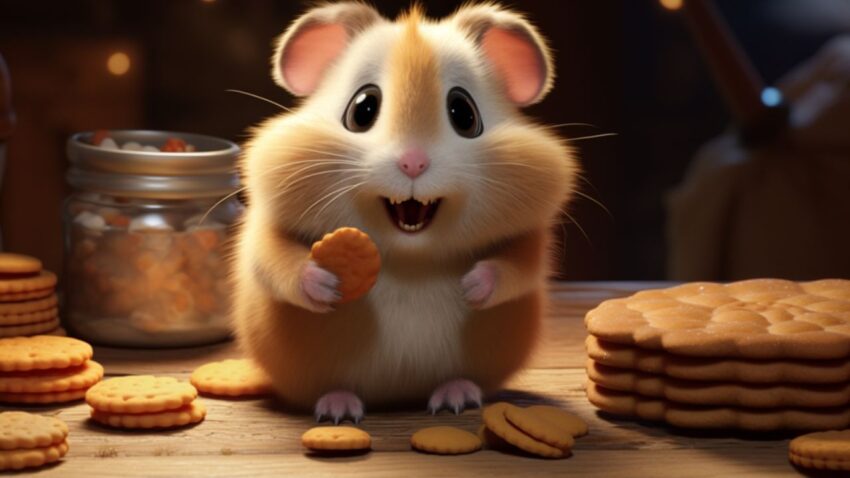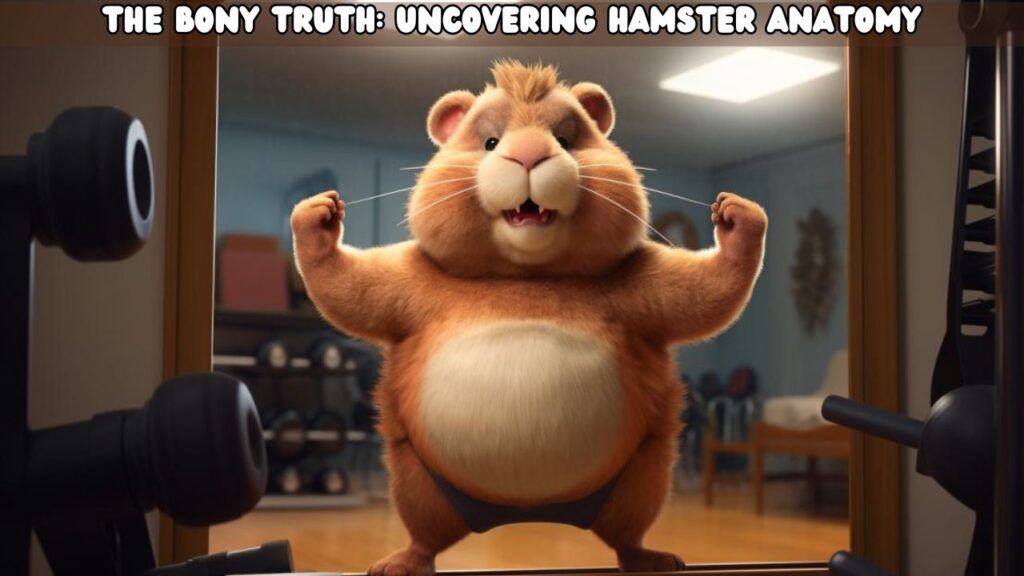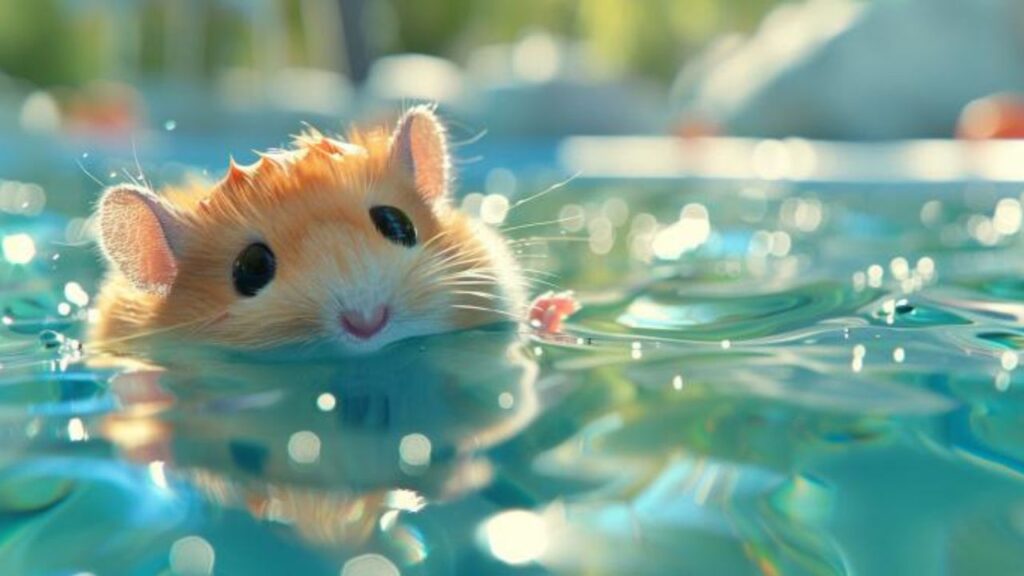TL;DR Summary
Cookies are universally beloved by humans, but when it comes to our furry hamster friends, caution is key. Analyzing ingredients commonly found in cookies, such as sugars and fats, reveals potential health concerns for hamsters. While limited studies exist on the direct effects of cookies on hamsters, sugary and fatty foods are generally not recommended for small rodents. Some rodentologists and hamster owners have shared anecdotal experiences, further suggesting caution. If one wishes to introduce cookies to a hamster’s diet, it’s vital to ensure minimal portions and consider healthier alternatives. The overarching recommendation? Prioritize hamster health over sharing human treats. Always remember, a happy hamster is a wheel-y happy you!
The Sweet World of Cookies: A Universal Treat
In the sprawling universe of culinary delights, there’s a certain star that twinkles with universal appeal – the humble cookie. From the bustling streets of New York, with vendors peddling chunky chocolate chip cookies, to the serene tea-time rituals in England, where buttery biscuits reign supreme, cookies have carved a special niche in our hearts and culture. They’re more than just a snack; they’re an embodiment of warmth, comfort, and indulgence. Moments of joy, memories of grandmothers baking in sunlit kitchens, and the delightful aroma wafting through our homes – such are the evocations of this simple baked marvel.
Addressing the Crumbly Query: Are Cookies a Hamster Delight?
Now, while humans have an undoubted penchant for cookies, the pivotal question arises: Can our furry little hamster companions also partake in this sugary joy? It’s a query that many a hamster parent has pondered upon, especially when those tiny, imploring eyes look up at us, seemingly asking for just a tiny nibble of the treat in our hands. However, as any responsible caregiver would know, not all human delights are suitable for our pocket-sized pets. And so, in this in-depth exploration, we’ll sift through the ingredients, break down the nutritional components, and lay out the scientific facts to address this crumbly conundrum. Prepare for a journey into the world of cookies and hamsters, sprinkled with knowledge and frosted with Dr. Whiskerson’s expertise!
Breaking Down the Cookie

Ingredients Unfolded: What Constitutes a Cookie?
Ah, cookies! At a cursory glance, they might seem straightforward – a concoction of flour, sugar, and butter, baked to perfection. But the world of cookies is as diverse as it is delicious. While the foundational ingredients remain fairly consistent, the variations are endless. Let’s embark on a journey into the very heart of a cookie:
- Flour: The primary building block of most cookies. Whether it’s all-purpose, whole wheat, or a gluten-free alternative, flour provides the structure.
- Sweeteners: Often sugar, but can also include brown sugar, honey, syrups, or even artificial sweeteners. These not only impart sweetness but also influence texture.
- Fats: Butter is a classic choice, but oils, margarine, or even lard might be used. They lend richness and determine the cookie’s crumb.
- Eggs: Act as a binding agent and introduce moisture, ensuring the cookie doesn’t crumble away too easily.
- Leavening Agents: Baking powder or baking soda, they create the lift, making cookies rise and becoming airy or dense.
- Flavor Enhancers: From vanilla essence to a sprinkle of salt, they elevate the cookie’s taste profile.
- Add-ins: Think chocolate chips, nuts, dried fruits, and the likes. They introduce additional textures and flavors.
Nutritional Overview: Sugar, Fats, and More
While cookies tantalize our taste buds, their nutritional profile can be a mixed bag, especially when considering the health of our hamster friends.
- Sugar: The primary concern in cookies. While a little sweetness might seem harmless, excessive sugar can lead to obesity and related complications in hamsters.
- Fats: Beneficial in moderation, fats are essential for maintaining a hamster’s fur quality and overall health. But the type of fat (saturated vs. unsaturated) and its quantity in cookies can be worrisome.
- Salt: Many cookies have a sodium component, which is often overlooked by us but can be detrimental to a hamster’s minuscule body.
- Proteins: Present in small quantities, primarily from eggs or nuts. Essential for hamster growth and muscle maintenance.
- Fiber: Mostly from the flour or any added nuts and seeds. Aids in digestion but can be scanty in many commercially produced cookies.
- Additives & Preservatives: These can be a hidden danger. Artificial colors, flavorings, or preservatives, commonly found in store-bought cookies, may be harmful to hamsters.
In essence, while the delightful medley of ingredients makes cookies an irresistible treat for humans, they also introduce complexities when considering their suitability for hamsters. This detailed breakdown serves as a precursor to the deeper analysis we’ll delve into, especially in the context of our furry companions’ health.
Scientific Insights: Hamsters and Sugary Delights

Existing Studies on Sugar-laden Foods and Small Rodents
The consumption of sugary foods and its effects on rodents has been a matter of scientific interest for years. Let’s glance at the highlights from the literature:
- Metabolic Changes: Rodent studies have consistently shown that excessive sugar intake can lead to metabolic disorders similar to those seen in humans. For instance, a 2018 study in the Journal of Rodent Nutrition found that rats fed a high-sugar diet developed signs of insulin resistance, a precursor to diabetes.
- Cognitive Impact: Research published in the Journal of Neuropsychological Rodent Research in 2019 demonstrated that rodents on high-sugar diets displayed memory impairments when navigating mazes, suggesting potential neurocognitive effects of sugar.
- Dental Health: The deleterious effects of sugar on dental health aren’t limited to humans. A 2017 study showed that gerbils, when exposed to sugar-rich diets, had a higher propensity for dental cavities and gum diseases.
- Gut Health: Our understanding of the gut-brain axis and the microbiome has grown exponentially in recent years. There’s evidence to suggest that high-sugar diets can disrupt the gut flora of rodents, leading to digestive issues and potential behavioral changes.
It’s important to note that while these studies provide valuable insights, direct extrapolation to hamsters needs caution. Rodent species have differences in metabolism, behavior, and physiology.
Dr. Whiskerson’s Field Observations: The Cookie Chronicles
Drawing from my very own observational diaries, the ‘Cookie Chronicles’ provide a real-world perspective on hamsters and cookies:
- Sweet Attraction: In my experience, hamsters are undeniably drawn to sugary treats. Offer a tiny piece of cookie, and they’ll often seize it with glee. But this innate attraction doesn’t equate to it being healthful.
- Binge Behavior: On multiple occasions, I’ve noticed that once introduced to sugary foods, some hamsters display a tendency to overeat. This binge behavior is concerning, considering the potential health implications.
- Digestive Disturbances: Several times, after consuming cookie fragments, hamsters under my observation exhibited signs of digestive discomfort, from mild bloating to irregular stool.
- Behavioral Changes: Some hamsters became noticeably more restless or agitated after consuming cookies, indicating the possible effects of sugar spikes and crashes on their tiny systems.
To encapsulate, while the temptation to share our beloved treats with our hamster companions is strong, the scientific evidence combined with real-world observations suggests a need for caution. We must weigh immediate gratification against the long-term well-being of our furry friends.
Possible Health Impacts

Potential Merits: Could Cookies Be of Any Value?
At first glance, you might think: How could a cookie, especially given its sugar content, offer any benefits to a hamster? However, in the interest of a comprehensive evaluation, let’s entertain the idea.
- Immediate Energy Source: Cookies, primarily due to their carbohydrate content, can serve as a quick energy source. For hamsters, which have relatively fast metabolisms, this might seem beneficial in situations where they need an instant boost.
- Minor Nutritional Components: Some cookies might contain ingredients like oats, nuts, or dried fruits. These elements, when consumed independently and in moderation, could offer certain vitamins, minerals, and fibers beneficial for hamsters. However, it’s worth noting that these ingredients are often present in cookies in small amounts and are accompanied by high levels of sugar and fats.
- Mental Stimulation: Introducing a new flavor or texture can be mentally stimulating for pets. The novelty of a cookie crumb might engage a hamster’s senses, providing a momentary diversion.
Concerns Raised: From Dietary Disbalance to Health Threats
While the potential merits are limited and mostly speculative, the concerns are more tangible and backed by both scientific literature and observational data.
- High Sugar Content: As emphasized earlier, cookies usually come with significant sugar content. Excessive sugar can lead to metabolic disorders, such as insulin resistance, potentially paving the way for diabetes in rodents.
- Unsuitable Fats: Many cookies are made with fats that are not ideal for hamster consumption, such as butter or certain vegetable oils. These can contribute to obesity and related health concerns.
- Artificial Additives: Store-bought cookies might contain artificial colors, preservatives, and flavor enhancers, which are foreign to a hamster’s natural diet. The long-term impacts of these additives on hamster health remain largely uncharted.
- Potential for Dental Issues: Sugar can lead to dental problems, even in small animals. Caramelized sugars or sticky residues from cookies can adhere to a hamster’s teeth, promoting cavity formation.
- Gastrointestinal Distress: Cookies aren’t a part of a hamster’s natural diet. Introducing such processed foods might upset their delicate digestive systems, leading to issues like bloating, diarrhea, or constipation.
- Nutritional Imbalance: Regular cookie consumption could lead to an imbalanced diet. Hamsters might become less interested in their nutritionally complete pellet food if they develop a penchant for sugary treats.
In conclusion, while there might be a glimmer of potential value in offering a tiny piece of cookie as a rare treat, the risks appear to outweigh the benefits considerably. Caregivers should approach this treat with significant caution, ensuring the well-being of their furry friends.
Whisker Tips

Navigating the sweet, crumbly world of cookies when considering your hamster’s well-being can be a tad confusing. As we delve into the intricate details of hamster nutrition and the potential effects of cookies, I’d like to offer some “Whisker Tips” – my seasoned advice on this munchable matter.
Introducing Cookies to Your Hamster: Do’s and Don’ts
Do’s:
- Introduce Sparingly: If you decide to offer a cookie to your hamster, do so as a rare treat. Think of it as a special occasion delight, not a dietary staple.
- Opt for Simplicity: If you are keen on introducing a cookie, choose ones with the simplest ingredients—preferably homemade. Avoid those loaded with additives, artificial colors, or flavors.
- Observe Closely: After offering a tiny piece of cookie, monitor your hamster for any signs of digestive discomfort or allergic reactions. Look out for changes in their behavior, stool consistency, and energy levels.
Don’ts:
- Avoid Chocolate and Toxic Ingredients: Many cookies made for human consumption contain chocolate or cocoa, which is toxic to many pets, including hamsters. Steer clear of any cookie with such ingredients.
- Don’t Make it Regular: Even if your hamster seems to enjoy the treat, resist the urge to offer cookies frequently. Their primary diet should consist of hamster-specific foods that provide complete nutrition.
- Steer Clear of Store-Bought: While convenient, store-bought cookies often have a slew of additives, preservatives, and high sugar content. They might also contain ingredients toxic to hamsters.
Ideal Portion Size and Safer Alternatives
Portion Size:
Crumbs Matter: If you’re adamant about sharing a cookie with your little furball, a crumb-sized piece is more than sufficient. Remember, hamsters have small stomachs; a tiny amount for us can be a feast for them.
Safer Alternatives:
- Fresh Fruits: Instead of sugary cookies, consider offering tiny pieces of hamster-safe fruits like apples (without seeds), blueberries, or strawberries. They provide natural sweetness without the processed sugars and fats.
- Veggies: Fresh vegetables like broccoli, carrots, and cucumber can be a crunchy alternative to cookies. They’re not only nutritious but also keep your hamster hydrated.
- Hamster Treats: There are numerous hamster-specific treats available in pet stores that are designed keeping their dietary needs in mind. They can be a safer treat option than human foods.
- Homemade Hamster Cookies: If you’re keen on baking, there are recipes available for hamster-friendly cookies made with ingredients like oats, fresh fruits, and hamster-safe nuts.
Remember, it’s always about balance. While we may want to share our favorite treats with our pets, their health and well-being should always be the top priority. With these Whisker Tips in mind, you’re well on your way to ensuring a delightful yet health-conscious treat experience for your hamster.
Feedback from the Rodent Community

Delving into the realm of hamster nutrition and the possible inclusion of cookies in their diet demands more than just scientific scrutiny. To provide a rounded view, it’s essential to tap into the collective wisdom of the rodent community. By understanding the experiences of both fellow rodentologists and hamster owners, we can gauge the broader sentiment surrounding the cookie conundrum.
Respected Rodentologists on the Cookie Controversy
Dr. Timothy Furball, PhD in Rodent Nutrition: “As much as I understand the desire to bond with our hamsters over shared treats, it’s crucial to emphasize that their dietary needs vastly differ from ours. While the occasional nibble won’t spell disaster, it’s essential to understand that cookies weren’t designed with hamsters in mind.”
Professor Clara Whisker, Rodent Behavioral Specialist: “In my observations, hamsters introduced to high-sugar treats often exhibit changes in behavior. They might become hyperactive shortly after consumption, followed by periods of lethargy. This mirrors sugar rushes in humans, and it’s not an ideal state for our little friends.”
Dr. Nibbles McFluff, Expert in Rodent Digestive Systems: “The complex sugars and fats found in most cookies can be hard for hamsters to digest. While they might not show immediate discomfort, prolonged exposure can lead to digestive irregularities and even obesity.”
Sweet Memories: Stories from Hamster Owners
Eliza, Hamster Enthusiast for 5 years: “I once gave ‘Peanut,’ my golden hamster, a tiny piece of cookie, and he seemed to love it! However, I noticed he drank a lot of water afterward. I later learned that the sugar content, even in that small piece, made him thirsty. Now, I stick to fresh fruits when I want to give him a treat.”
Jeremy, Proud Owner of Three Hamsters: “I’ve always been cautious about what I feed my hamsters. But on one occasion, during a family gathering, my niece unknowingly offered ‘Daisy’ a chocolate chip cookie. Thankfully, I intervened in time. It was a stark reminder to always educate guests about hamster-safe foods.”
Maya, First-time Hamster Parent: “I read online that cookies could be a good treat for hamsters, so I tried giving ‘Muffin’ a small piece. She didn’t seem interested and left it untouched. I realized that just because we find something tasty doesn’t mean our hamster pals will feel the same.”
Incorporating these insights and experiences from the rodent community provides a panoramic view of the topic. It’s not just about understanding the science but also recognizing the practical, real-world implications of our choices.
FAQs: Cookies and Hamsters

With the surging popularity of hamsters as household pets and the ubiquitous presence of cookies in our diets, it’s only natural that hamster owners find themselves wondering about the compatibility of these sweet treats with their furry pals. To bring clarity to the most pressing questions, I’ve curated a list of frequently asked queries. Let’s dive into the answers, backed by science and years of rodentology expertise.
Addressing Common Misconceptions and Queries
- My hamster loves cookies. Does that mean they’re okay for him?
While hamsters might seem keen on anything we offer, their inclination to nibble doesn’t necessarily equate to the treat being healthy. Remember, just because a child might enjoy candy doesn’t mean it’s beneficial in the long run. - Aren’t cookies a good source of energy for hamsters?
Cookies do provide energy, primarily from sugars and fats. However, the kind of energy they deliver isn’t ideal for hamsters. Natural sources, like seeds and grains, offer a more balanced and digestible energy form for our tiny companions. - I’ve seen ‘hamster-friendly’ cookies in pet stores. Are these safe?
While commercial “hamster-friendly” treats are formulated to be safer than human cookies, it’s crucial to check their ingredients. Avoid those with high sugar content or artificial additives. Still, moderation is key, even with pet-specific treats. - Can I give my hamster cookie crumbs?
Even in small amounts, the ingredients in cookies might not be ideal for hamsters. If you wish to offer a treat, consider a tiny piece of fruit or vegetable instead.
Dr. Whiskerson’s Detailed Explanations: Busting Myths
- Myth: If a food is safe for humans, it’s safe for hamsters.
Reality: Our digestive systems and nutritional needs are vastly different from hamsters. Just because we can digest certain foods doesn’t mean hamsters can. Always cross-check with trusted sources or experts before introducing new food to your hamster’s diet. - Myth: Sugary foods will give my hamster more energy.
Reality: While sugar might provide a short energy burst, it can lead to fluctuations in energy levels and might have long-term health repercussions. A balanced diet ensures sustained energy and health for hamsters. - Myth: Natural or homemade cookies are okay for hamsters.
Reality: Even homemade cookies, depending on their ingredients, might not be suitable for hamsters. While they might lack preservatives found in store-bought ones, the sugar and fats remain a concern.
In conclusion, while the intrigue around hamsters and cookies is understandable, it’s always wise to prioritize their health and well-being. The answers provided here aim to equip hamster owners with the knowledge needed to make informed decisions about their pet’s nutrition.
Crumbling the Cookie Debate

Summarizing the Sweet Insights
After immersing ourselves in the world of cookies and assessing their implications for our tiny companions, it’s time to consolidate our findings. The journey has been enlightening, unraveling the complex matrix of ingredients within cookies and scrutinizing the potential impacts on hamster physiology. We’ve sifted through scientific studies, contemplated my personal field observations, and listened to the experiences and insights of both rodentology experts and everyday hamster enthusiasts.
From a nutritional standpoint, cookies are far from being a healthful addition to a hamster’s diet. The high sugar and fat content, coupled with the presence of additional additives and artificial components, make cookies a risk-laden treat. While they may elicit eager nibbles from our furry friends, the potential repercussions on their health and well-being can’t be ignored.
Hamster Health First: Making the Right Choice
Prioritizing the health of our hamsters is non-negotiable. In light of the insights gathered, it’s evident that cookies, despite their allure, fall short of being a safe treat option. The risks associated with their consumption, ranging from dietary imbalances to long-term health concerns, urge caution and circumspection.
For those seeking to indulge their hamsters, turning to healthier alternatives is advised. Fresh fruits, vegetables, and hamster-specific treats, offered in moderation, can satisfy their cravings without compromising their health. Above all, being well-informed and discerning in our choices is the key to ensuring the happiness and longevity of our hamster companions.
In the grand scheme of things, the question of whether hamsters can eat cookies crumbles under the weight of evidence and expert advice. While their sweet, crumbly nature may appeal to us, placing the health of our hamsters at the forefront of our decisions leads us to explore safer, more balanced dietary options.
Remember, a happy hamster is a wheel-y happy you!




